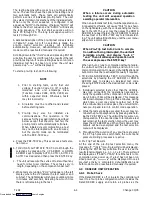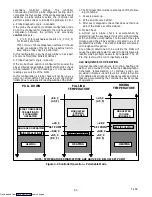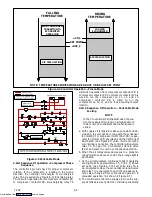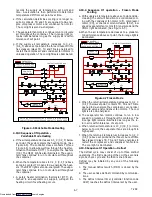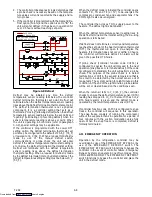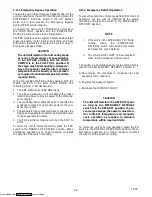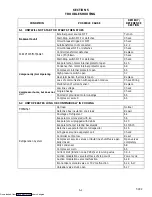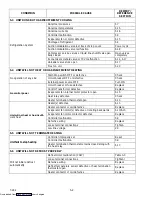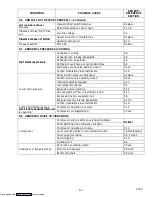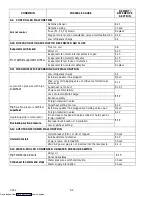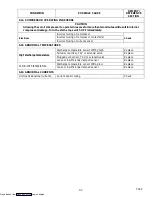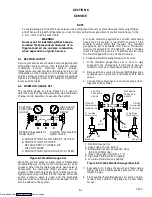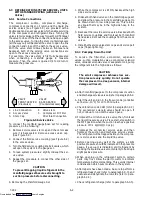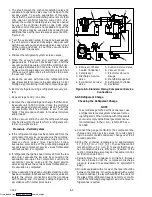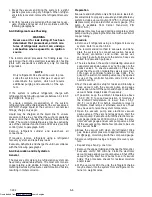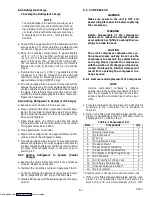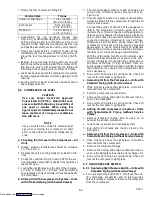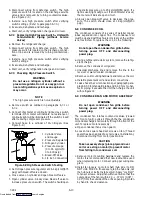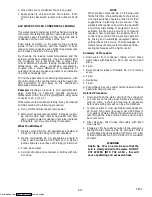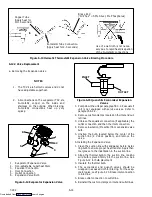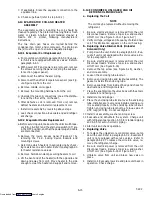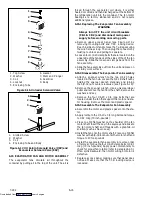
6-2
T-292
6.3 REFRIGERATION SYSTEM SERVICE-- UNITS
WITH STANDARD PIPING (with Service
Valves)
6.3.1 Service Connections
The compressor suction, compressor discharge,
compressor economizer, oil return and the liquid line
service valves (see Figure 6-3) are provided with a
double seat and an access valve which enable servicing
of the compressor and refrigerant lines. Turning the
valve stem clockwise (all the way forward) will frontseat
the valve to close off the line connection and open a path
to the access valve. Turning the stem counterclockwise
(all the way out) will backseat the valve to open the line
connection and close off the path to the access valve.
With the valve stem midway between frontseat and
backseat, both of the service valve connections are
open to the access valve path.
For example, the valve stem is first fully backseated
when connecting a manifold gauge to measure
pressure. Then, the valve is opened 1/4 to 1/2 turn to
measure the pressure.
VALVE
FRONTSEATED
(Clockwise)
VALVE
BACKSEATED
(Counterclockwise)
5
1
2
3
4
1. Line Connection
2. Access Valve
3. Stem Cap
4. Valve stem
5. Compressor Or Filter
Drier Inlet Connection
Figure 6-3 Service Valve
To connect the manifold gauge/hose set for reading
pressures, do the following:
1. Remove service valve stem cap and check to make
sure it is backseated. Remove access valve cap.
(See Figure 6-3)
2. Connect the field service coupling (see Figure 6-2)
to the access valve.
3. Turn the field service coupling knob clockwise, which
will open the system to the gauge set.
4. To read system pressures: slightly midseat the ser-
vice valve.
5. Repeat the procedure to connect the other side of
the gauge set.
CAUTION
To prevent trapping liquid refrigerant in the
manifold gauge set be sure set is brought to
suction pressure before disconnecting.
b. Removing the Manifold Gauge Set
1. While the compressor is still ON, backseat the high
side service valve.
2. Midseat both hand valves on the manifold gauge set
and allow the pressure in the manifold gauge set to
be drawn down to low side pressure. This returns
any liquid that may be in the high side hose to the
system.
3. Backseat the low side service valve. Backseat both
field service couplings and frontseat both manifold
hand valves. Remove the couplings from the access
valves.
4. Install both service valve stem caps and service port
caps (finger-tight only).
6.3.2 Pumping Down the Unit
To service the filter-drier, economizer, expansion
valves, suction modulation valve, economizer solenoid
valve, unloader solenoid valve or evaporator coil, pump
the refrigerant into the high side as follows:
CAUTION
The scroll compressor achieves low suc-
tion pressure very quickly. Do not operate
the compressor in a deep vacuum, internal
damage will result.
a. Attach manifold gauge set to the compressor suction
and discharge service valves. Refer to paragraph 6.2.
b. Start the unit and run in the frozen mode (controller
set below --10
°
C) for 10 to 15 minutes.
c. Check function code Cd21 (refer to paragraph 3.2.2).
The economizer solenoid valve should be open. If
not, continue to run until the valve opens.
d. Frontseat the oil return service valve then, frontseat
the liquid line service valve. Place start-stop switch in
the OFF position when the suction reaches a positive
pressure of 0.1 kg/cm
@
(1.0 psig).
e. Frontseat the economizer service valve and then
frontseat the suction and discharge service valves.
The refrigerant will be trapped between the compres-
sor service valves and the liquid line valve.
f. Before opening up any part of the system, a slight
positive pressure should be indicated on the pressure
gauge. If a vacuum is indicated, emit refrigerant by
cracking the liquid line valve momentarily to build up a
slight positive pressure.
g. When opening up the refrigerant system, certain
parts may frost. Allow the part to warm to ambient
temperature before dismantling. This avoids internal
condensation which puts moisture in the system.
h. After repairs have been made, be sure to perform a
refrigerant leak check (refer to paragraph 6.3.3), and
evacuate and dehydrate the low side (refer to para-
graph 6.3.4).
i. Check refrigerant charge (refer to paragraph 6.3.5).
Downloaded from
Summary of Contents for 69NT40-531 Series
Page 2: ...Downloaded from ManualsNet com search engine ...
Page 4: ...Downloaded from ManualsNet com search engine ...
Page 8: ...Downloaded from ManualsNet com search engine ...
Page 16: ...Downloaded from ManualsNet com search engine ...
Page 57: ...Downloaded from ManualsNet com search engine ...
Page 104: ...Downloaded from ManualsNet com search engine ...
Page 106: ...7 2 T 292 Figure 7 2 SCHEMATIC DIAGRAM Downloaded from ManualsNet com search engine ...



